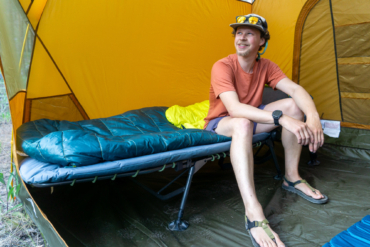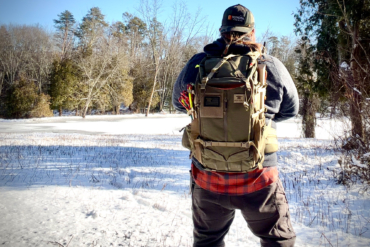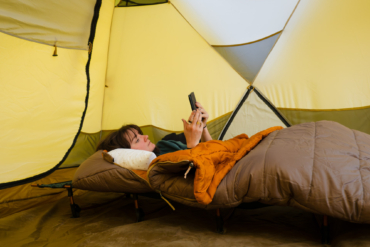
(About the author: Christopher Ketcham divides his time between Brooklyn, N.Y., and Moab, Utah, and writes for a range of national publications. This syndicated article first ran in High Country News.)
I keep hearing that the art of backpacking is dying. Usually the messenger is an older person with the tone of the gentle curmudgeon who can’t understand why the damn kids aren’t interested in hauling 40 pounds into wilderness on a forced march day after day over rough earth, under rain and sun, in order to drink unbottled water of unknown provenance, with a slimy helping of beaver piss and dirt, eat gruel at dusk, be attacked from ankle to earlobe by insects, be watched by carnivores with eyes gleaming in the dark and by mice scheming for gorp, only to crash exhausted to the ground in a sleeping bag that quickly transforms (as the ornery desert scribe Ed Abbey observed) into a greasy fart-sack, and be woken far too early, with the cruel lash of sun-up and the birdsong bouncing on your tympanum like a pogo stick.
Steve Allen, who is 62, a backcountry guide, and the author of many guidebooks, which, if correctly used with several compasses, will get you deep into Utah canyons and possibly back out, tells me he and his friends – other curmudgeons, apparently – almost never see young people on the trails they frequent. Sure, there are outliers, the few Outward Bound and National Outdoor Leadership School groups, and occasional college students who have a bolder vision of spring break than being a body cameo’d on Girls Gone Wild videos. “Mostly we see older folks in their 50s and even into their 60s and 70s,” says Allen. He describes himself, proudly if hubristically, as part of a generation, the Boomers of the 1960s and 1970s, that “led the exodus into the backcountry.”
His generation read Renny Russell’s 1967 On the Loose. “It feels good to say ‘I know the Sierra’ or ‘I know Point Reyes,’ “ wrote Russell. “But of course you don’t – what you know better is yourself, and Point Reyes and the Sierra have helped.” They also read Colin Fletcher’s 1960s books celebrating his epic backpacking: The Thousand Mile Summer, The Man Who Walked Through Time – about hiking the length of the Grand Canyon – and The Complete Walker, which sold 500,000 copies, “still the how-to bible on backpacking,” assures Allen. Maybe they even read Walt Whitman: “Now I see the secret of the making of the best persons. It is to grow in the open air, and to eat and sleep with the earth.”
“We wanted to get away from it all,” says Allen, “to find peace and quiet as far from the noise of society as we could get. And we did.”
The Complete Walker? Isn’t that what my grandmother had to use in her last days? I just turned 40, and I go out backpacking every year for a few weeks at a time, usually solo. Why? Because I like to be alone, sure, but also because I often find that friends of my own age won’t join in the wretched fun.
Even in Moab, Utah – the so-called “Adventure Capital of the World” – where I used to live and to which I return every year for a month or so to reconnoiter the sun-smashed redrock desert, I find that almost no one I know who is 40 or younger goes backpacking. This is a kind of heartbreak. The problem might be one of marketing. Backpacking doesn’t require much gear (the less the better) or expertise (why trust the experts?), and, if you plan it right, it poses little danger (my own preference). Who wants to market such things? There’s no money in it.
Another friend of mine – well-educated, well-read, in his late 40s, but de facto homeless, without a car, an inveterate hitchhiker, an itinerant laborer in Colorado and Utah who spends at least 200 days of the year backpacking in the canyonlands – tells me that he too can’t recruit backpacking companions. Instead, he encounters “gearheads” – people who see the outdoors as an arena for deploying the latest technological toys, such as mountain bikes that ride for you, or carabiners that talk, or apps for both. People, that is, who spend a lot of time caressing, naming, oiling, sleeping and playing with inanimate objects, as advertised that they should do in the “Adventure Capital.” Then, post-adventure, they recover in various homes with the masses, such as the double-wide tent by the river, with the cooler full of beer, the gas stove searing meat, or to the Motel 6 or Best Western, with the air conditioner and the TV making conversation, as promised on the billboards outside town.
Anecdotal evidence, I know, but it’s reinforced by the experts who compile outdoor recreation statistics. Chris Doyle, executive director of the Adventure Travel Trade Association, describes “a well-known trend” in outdoor gear sales, wherein day packs take an increasing share of the pack market while technical overnight packs are a declining percentage of total sales. “The same is true for heavy, extended-trip boots versus light boots,” says Doyle. “This is all part of a trend toward ‘Done in a day’ that reflects consumers’ continued interest in outdoor adventures, but they prefer to be in their own bed or another comfortable spot (hotel or lodge) at night.”





